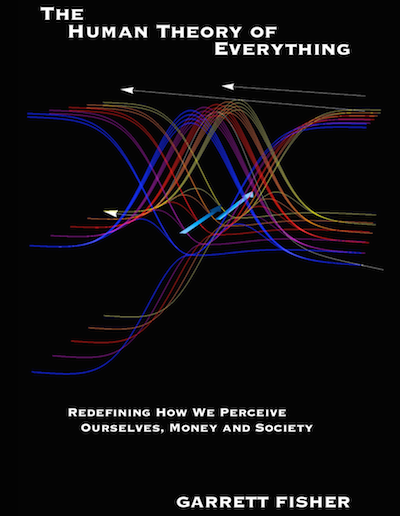“The Human Theory of Everything” is my first book. In 2012, the concept came to me first in a series of observed correlations between various probabilities, human perception, and a diffluence between perception and measurable reality . It then grew into a theory of mine, that one can distill human motivators, and by extension global economics, into simple drivers. It is often extremely complex to decode a system or devise an invention; once that accomplishment is achieved, it is very easy for humans to operate, enjoy, and benefit from the effects of said discoveries. In this concept, it would be logical that human behavior is rooted in DNA, shares species-wide commonality, and once decoded, would make a bunch more sense than watching groups of people do seemingly silly and random acts. From human motivators, one can map to fields of psychology, and more significantly, economics. Every purchase and sale that occurs is a product of human motivation, which derives from a semi-mysterious web of motivators, or so it seems.
At any rate, I thought my theories were the cat’s meow at the time. They are definitely very interesting, which gave rise to a TEDx talk (note on the menu for a link), and also are elements of wisdom employed in my consulting practice. Out of fear that “someone will ‘discover’ the same thing in 40 years and get the credit instead of me,” I decided to secure naming rights to my landmark ethos by initially writing an academic paper. Aside from the tedium of being obliged to engage in a terrifying amount of [unfunded] scientific work, it also was evident to me that “nobody is going to read a paper, though they do read books.” So, I decided to become an author.
What began in North Carolina as a series of evening crazed musings in front of a computer grew into a passionate pastime upon my move to Breckenridge, Colorado. There, I sat every afternoon alongside the rushing Blue River with my MacBook, writing away and completing my first book within a few months. While I expected to become obscenely wealthy and a household name from my illustrious discoveries, I most certainly did not expect to mix my photography pursuits with publishing, and then mix my love for aviation with photography and publishing. Half a decade and 22 more books later, I now sit alongside beautiful mountain streams in Europe, cooking up travel-infused word salads that I sell to the general public while wondering how this all happened.
If one is cautiously intrigued by my theories yet wishes to not spend hard-earned cash on it, the Kindle version can be obtained through Kindle Unlimited or the Kindle Lending Library for free.
Chapter Listing
1 Why the Human Theory of Everything?
2 Where Did the Economy Come From?
3 The Importance of How the Economy Came to Be
4 Why I Wrote the Book
5 The Mysterious Power of “They”
6 Hard Work is Over Rated
7 What Does the Market Reward?
8 Bell Curves
9 How Bell Curves Fit in to the Human Theory of Everything
10 Mind to Market
11 The Presence of Forces and its Influence on Equilibrium in Economic Models
12 Translating Economic Transactions to Motivating Forces
13 Economic Intransigence
14 The Mathematics Behind Human Thinking
14.1 Negatives and Positives
14.2 Quantity
14.3 Pain and Pleasure
14.4 Probability
14.5 Impact
14.6 Intermediate Step – Putting Negative, Positive, Quantity, Pleasure, Pain, Probability & Impact Together
14.7 Control
14.8 Actual Safety
14.9 Putting it all Together
15 Economic Zero
16 Categorizing the System
16.1 Controllable
16.2 Plannable – The Positive Side
16.3 Preventable – The Negative Side
16.4 Unpredictable – The Negative Side
16.5 Unpredictable – The Positive Side
16.6 Market Creation – The Positive Side
16.7 Market Destruction – The Negative Side
17 Percentages in Each Category
18 Maximum Gain
19 The Model – From a Micro to Macro Scale
20 Mathematically Predictable Obsolescence
21 Effecting Change
22 The Problem With Economics
23 My Vision
24 Appendix – Methods
25 Table of Diagrams
26 Bibliography
27 Author
Diagram Listing
Diagram 1 – Human Theory of Everything
Diagram 2 – Human Thought Profiles
Diagram 3 – Where Monetary Economies Originate
Diagram 4 – IQ Bell Curve
Diagram 5 – Mind to Market
Diagram 6 – The Theory of Everything
Diagram 7 – Elliott Waves
Diagram 8 – Positives & Negatives
Diagram 9 – Quantity
Diagram 10 – Pain & Pleasure
Diagram 11 – Pain, Pleasure & Quantity
Diagram 12 – Probability
Diagram 13 – Impact
Diagram 14 – Probability & Impact
Diagram 15 – Probability & Impact with Fear & Denial
Diagram 16 – Quantity, Pain, Pleasure, Pain, Probability & Impact
Diagram 17 – Probability, Impact & Control
Diagram 18 – Control
Diagram 19 – Perceived Safety & Control
Diagram 20 – Perceived Safety, Actual Safety & Control
Diagram 21 – Entire Model
Diagram 22 – Economic Zero
Diagram 23 – Entire Model, Categorized
Diagram 24 – Emotional Power
Diagram 25 – Entire Model with Percentages
Diagram 26 – Safety Gain
Diagram 27 – Entire Model Categorized with Safety Gain
Diagram 28 – Law of Diffusion of Innovations
Diagram 29 – Corporate Maturity Cycle
Diagram 30 – Model with Diffusion of Innovations & Corporate Maturity Cycle
Diagram 31 – Entire Model Over Time
Diagram 32 – Model over Time with LDI and CDC
Diagram 33 – Change
Diagram 34 – Entire Model with Change Management
Diagram 35 – Entire Model with Change, LDI & CDC

